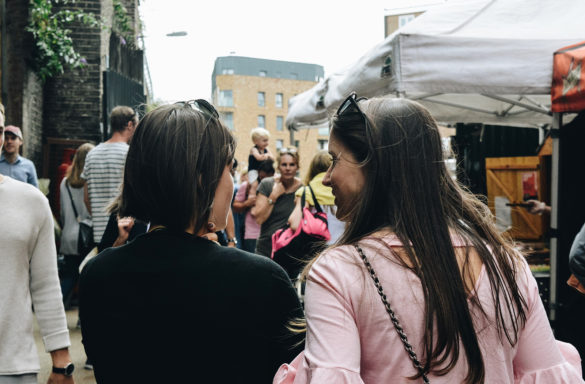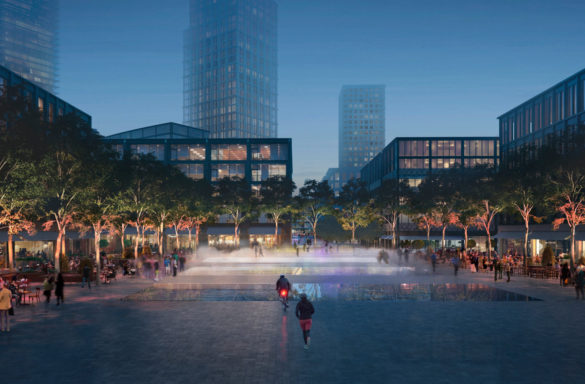ARTICLE
Architecture for a post pandemic world
4:38:00 18 January 2021
51°30’26”N 0°7’39”W
Researching last year the state of the highstreet and its post-pandemic future, we interviewed a tonne of architects, developers, and retail experts, among them Roger Madelin, principal force behind benchmark projects like Kings Cross and the new Canada Waters. Asked what the state of a post-pandemic highstreet and town centre in post-pandemic Britain, we were struck by his positivity, which favourably compares the next decade to the devil-may-care confidence of the Roaring Twenties.
It foreshadows in its confidence a recent Andrew Marr interview, this time the ex-Artistic Director of London’s National Theatre Nicholas Hytner. No fan of the present government, aghast at the silencing effect Covid has had on leisure and hospitality, Hytner is all the same blown away by the Culture Recovery Fund, which has effectively underwritten the infrastructure critical to the survival of the arts and culture industry post-pandemic. Similarly, he’s amazed at the language used to describe that industry relative to the country – beating heart, soul, lifeblood. It’s unusual to have such talk walked to the point of warding off an existential crisis. That the arts will rise again, he has no doubt.
Madelin, of course, was specifically talking about investment in the built environment and Hytner about artistic life in Britain, but both are confident in the resilience and innovativeness of the highstreet and town centre as the stage for a togetherness. More than anything, Hytner says, we are currently feeling the pain of the ‘absence of what we do together.’ That pain – which cuts the core of what it means to be a social being – is the out-of-necessity and damned-if-we-don’t driver for a confidence that will, we hope, transform the highstreet.
That confidence and that need to design our way out of the pain forms the basis of the below manifesto. A set of simple principles, it’s both vision and guide for what we – architects, designers, developers, policy makers – want to happen, and how to make it happen. It’ is the rather plain sounding A Manifesto for the High Street as Co-created Campus. We wonder whether, if only for now, we might call it a Manifesto for Roaring onto the Stage of Togetherness. Here it is, 10 points for a positive future:
1. Be socially useful
Have a higher purpose and know that that purpose is one and the same as being commercially astute. This is our North Star. Without it, we are nothing. It trumps reputation, depth of portfolio, short-term shareholder concerns. It guides investment, investigation, plans, design, build, activation and management. It balances purpose with profit. It’s B Corp for the high street. Take the long view. Be socially useful.
Post-pandemic design
Ensure that measuring social sustainability is a critical success factor added to all your Return Briefs. Work with developers that are not exclusively concerned with high absorption and rental rates and flipping product.
2. First and always life
Begin with life. Form may follow function, but both are meaningless unless guided by our rituals and our myths. Design for the local and the locale. Be open-minded ethnographers and open-sourced curators. Involve the people you serve. Stand in their shoes. Become their stories; then tell them – beautifully, with care.
Post-pandemic design
Before picking up the pen, make time for more human-centred research up front – and follow through with a detailed and ongoing process of post- occupancy evaluation.
3. Design for time well spent
Design for the service model. Know that real dwell time is not to be confused with the metrics of engagement and footfall. It is the quality of time spent that counts. Create a high street of great experiences. Ensure that it encourages a participation for the common good. Be guided by models – the turnover model, for example – that share in the risk and reward of the experience-led campus-like high street.
Post-pandemic design
Make the effort to storyboard your findings. There’s nothing like simple step- by-step storyboards – based on ethnographic research – illustrating how we go from attraction to involvement to belonging.
4. Make it an open platform
Involve all stakeholders in the planning, design, activation and management of the high street. Programme the various – daily, weekly, seasonal, physical, virtual – campus touchpoints through the lens of multiple and evolving types of use. Encourage facilitation rather than over-curation. Catalyse the small, the start-up, the local, the independent. Be a conscious experience masterplanner.
Post-pandemic design
Throughout the process, look to enable and host live experience workshops with key stakeholders.
5. Manage the experience
Know thy theatre. Plan for both back and front of house to have the people, the wherewithal, the skill set and the tools with which to create, facilitate and host the experience that is the high street. Invest in visionary, stakeholder- focused town-centre management teams, and give them sharp teeth – effective compulsory purchase/sale and vacancy management orders. Ensure landlord buy-in and tenant success.
Post-pandemic design
Make a point of identifying, recruiting and on-boarding activation team members from the outset – that is, the moment you enter the bidding process.
6. Think diverse input, rich output
Champion the importance of diversity and silo-busting at every level. Create diverse transdisciplinary design teams that reflect the stakeholders they serve. Think diverse process-input equals rich product-output – a virtuous circle, inspiring ongoing curiosity, debate and activism.
Post-pandemic design
Having properly understood your end user, ensure that the design team reflects that diversity of need and want. If you don’t have it, buy it in.
7. Masterplan for the journey
Consistently celebrate the importance of the narrative journey and how a rich mix of the long and the short, the big and the small, inspires a step-by-step wander to wonder. Ensure that curiosity is piqued with each turn. Seed sites with the installation, the pop-up, the start-up and the upstart. Attract, involve and create a sense of belonging. Know that the purchase funnel is the journey, played out in space, on campus. Design with the sensibility of a Harry Selfridge.
Post-pandemic design
Ensure that space is made for the short term, the small, the continuously evolving and the exceedingly generous. Hardwire them into the masterplanning so that they can’t be cost-engineered out over the design and procurement processes.
8. Adapt, reuse, and plan for redundancy
Make places and spaces flex with the ever-changing wants and needs of the tenants and their experience-hungry audiences. Be the eternally flexible co- created campus. Fall in love with the patina of adaptive reuse. Design generously, for now, next and after we’re gone. Give your buildings the versatility of the Victorian warehouse.
Post-pandemic design
Push for ‘experience-ready’ versatility, with multiple concepts for multiple scenarios.
9. Be beta-permanent
Learn from out-of-sector beta playbooks. Substitute build-and-they-will-come mantras for a much more fluid beta-plan approach to retail, one that takes a leaf out of the Silicon Valley book of the product in seemingly perpetual field test. The beta plan is the never-perfect plan. It’s rough and ready. It begins with making designers out of users. It involves people – customers, drinkers, diners, lovers, gawpers, travellers – in its constant making, and because it does, it learns – always and fast. Be beta-permanent.
Post-pandemic design
Make 28-day event licences and other similar relaxation of permission and licensing opportunities the norm. Design for the next experience.
10. Make it delightful
Make the most of the really real. Remember that it is the ever-morphing crowd of experiencing individuals that describes our high street. Design for delight. Encourage curiosity, sociability, and creativity. Let the Andy Pratts and Ross Baileys of this world have their way.
Post-pandemic design
Collaborate with the content providers wherever possible. Set up practice on the high street.
So, these are my working thoughts. Clearly, they are not necessarily Roger Madelin or Nicholas Hytner’s, whose names and thoughts I have rather taken in vain. However, I hope there’s some overlap, if not in detail, then certainly in tone. I’m not embarrassed to say that the chapter’s an ode to what it means to be together. We just need a new methodology for making our highstreets and town centres the stage for that togetherness. Time to start roaring.
Written by Adam Scott and Dave Waddell, the above manifesto is published in ‘RETHINK Design Guide: Architecture for a post-pandemic world’ (RIBA Books, 2021) as part of a chapter on the future of the retail and hospitality in post-pandemic Britain. Adam is hosting a podcast series on this called ‘The FreeThinking Podcast’ where Roger Madelin is one of his guests.
Click here to buy the book



